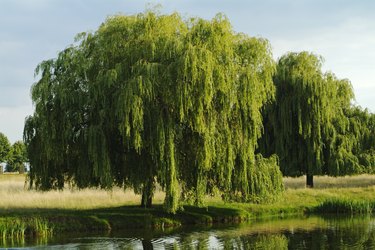
Legend has it, according to Bellamine University, that Alexander the Great's doom was sealed when a weeping willow branch brushed his crown from his head as he crossed the Euphrates; the event signaled his rapid demise to ancient Babylonian soothsayers who associated the tree with death, sorrow and tears. Among other willow species, modern gardeners are more likely to think of romance and fleeting beauty when they admire the weeping willow (Salix babylonica), since the tree loses its long, glorious tresses every autumn in its perennial range across U.S. Department of Agriculture plant hardiness zones 6 through 8.
Tip
Weeping willow is a deciduous tree, which means that it loses its leaves in autumn through winter until it leafs back out again in spring.
Video of the Day
Weeping Willow Leaves
The weeping willow is a graceful tree, growing 30 to 50 feet high with an equal spread. It is a backyard tree appropriate only for those with large properties who don't mind the cleanup on the ground when the leaves fall in autumn.
Video of the Day
Although the willow produces yellow flowers in springtime, the leaves are the main show. They grow simple and lance-shaped, up to 8 inches long and 4 inches wide. A tender green color when they appear in early spring, they quickly mature to dark green and then blaze yellow in autumn just before falling.
Weeping Willow's Annual Growth Cycle
As a deciduous plant, weeping willow in winter loses its leaves, but it's among the first trees to leaf out again the following spring. New growth appears in March or April in most areas, giving the bare branches a green hue.
The leaves grow in quickly, covering the tree in a matter of weeks. Cal Poly Urban Forest Ecosystems Institute notes that weeping willow is a fast-grower that adds 36 to 127 inches off height each year until the tree attains its mature size. In the fall, the willow leaves turn yellow but remain on the tree long after many other leaves have fallen. Weeping willow trees in winter enter a season of dormancy where the tree ceases growing and remains inactive.
Weeping Willow Roots
To irrigate all this foliage, willow roots aggressively seek water in the underlying soil, spreading three times as far as the tree's drip line in all directions. The roots remain fairly close to the surface but can easily become invasive. Think twice before planting a weeping willow near your sewer or water lines, since its roots are strong enough to break through pipes and lift sidewalks.
Many willows are planted near ponds and rivers to provide the thirsty roots with adequate irrigation. However, uncontrolled willows propagate quickly near streams and their roots and detritus can overwhelm a waterway.
Weeping Willow Care
Willows prosper in full sun to partial shade. They are tolerant of various soil types; the trees grow in clay, loam or sandy soil with a pH ranging from highly acidic to highly alkaline, as long as they get sufficient water.
Heed the Missouri Botanical Garden's caution, however, that weeping willow isn't a suitable choice for most residential landscapes because of its invasive roots and leaf litter. Cultivars exist that offer exotic leaves, but each grows best in a specific hardiness range.